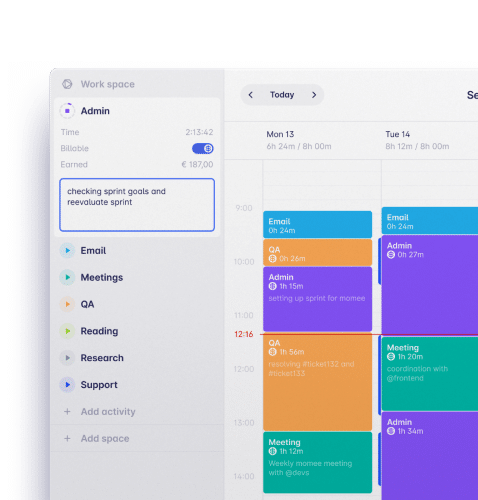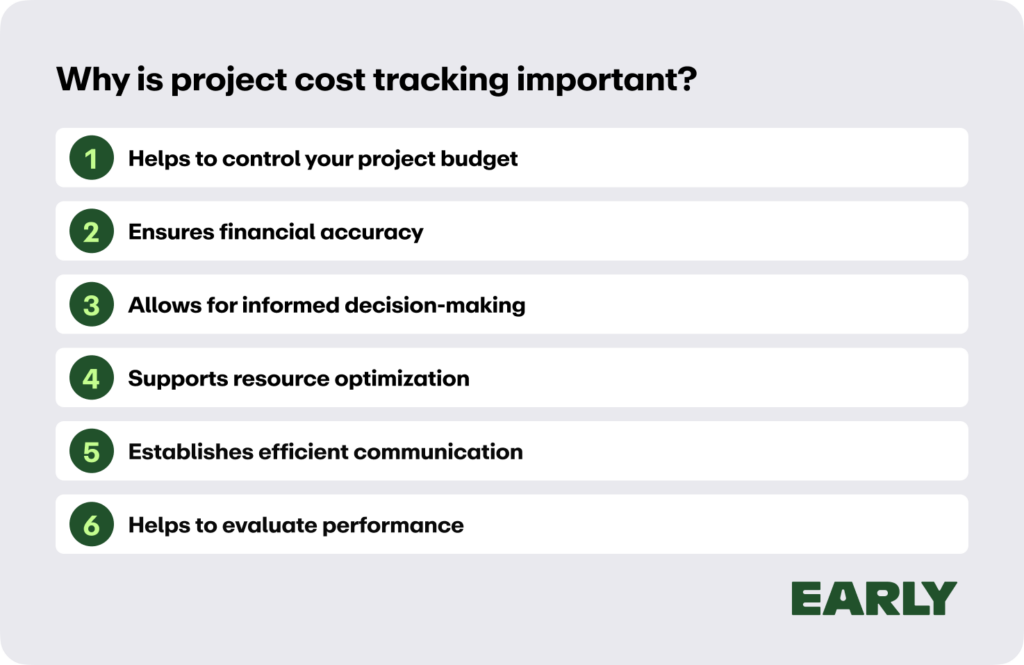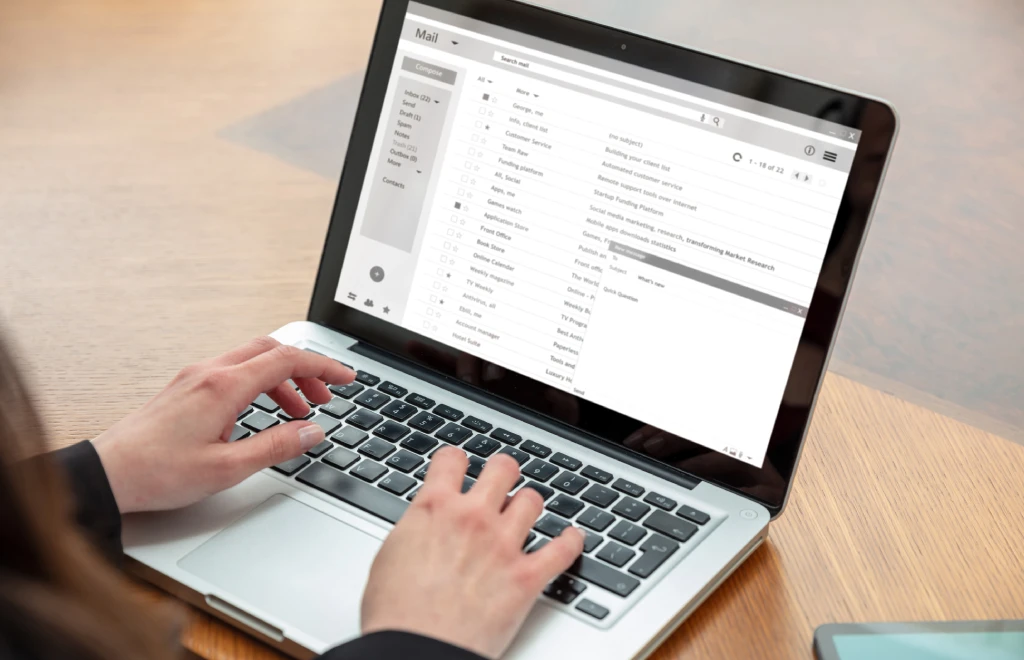Projektkostenverfolgung: 9 Wege zur Verfolgung von Projektkosten
In der heutigen Geschäftswelt kann die Optimierung der Projektkostenverfolgung eine Herausforderung darstellen. Probleme entstehen durch ungenaue Überwachung, schlechtes Management und mangelnde Echtzeittransparenz der Kostendaten.
Dieser Artikel bietet Lösungen zur Rationalisierung des Prozesses, die es Ihnen ermöglichen, Budgets zu kontrollieren, Kosten vorherzusagen und den Beteiligten genaue Kostenberichte zu liefern. Erwerben Sie Kenntnisse in der Projektkostenverfolgung und lindern Sie die damit verbundenen Schmerzen.
In diesem Leitfaden erfahren Sie, was sich hinter der Definition der Projektkostenverfolgung verbirgt , warum sie wichtig ist und wie man sie mit verschiedenen Methoden verfolgen kann.

Was ist die Projektkostenverfolgung?
Projektkostenverfolgung ist der systematische Prozess der Überwachung, Aufzeichnung und Analyse von Ausgaben, die während der gesamten Dauer eines bestimmten Projekts anfallen. Dazu gehört die sorgfältige Verfolgung und Dokumentation von Finanztransaktionen, um Einblicke in die Ressourcenzuweisung, die Nutzung und die Kostenanalyse zu gewinnen und eine fundierte Entscheidungsfindung zu ermöglichen.
Warum ist die Verfolgung der Projektkosten so wichtig?
Die Verfolgung der Projektkosten ist einer der wichtigsten Indikatoren für erfolgreichen Projektmanagements. Sie garantiert nicht nur finanzielle Stabilität, sondern ermöglicht es Ihnen auch, fundierte Entscheidungen zu treffen, die sich auf den Verlauf Ihres Projekts auswirken.

Hier sind die wichtigsten Gründe , warum die Verfolgung der Projektkosten so wichtig für die Entwicklung Ihres Unternehmens ist:
Haushaltskontrolle
Die Verfolgung der Projektkosten ist für die Kontrolle des Projektbudgets von entscheidender Bedeutung, da sie einen Echtzeiteinblick in die finanziellen Aspekte eines Projekts ermöglicht. Durch die genaue Überwachung und Aufzeichnung von Ausgaben können Organisationen:
- Verfolgung der Ausgaben im Vergleich zum zugewiesenen Budget,
- Identifizierung möglicher Kostenüberschreitungen oder -abweichungen,
- Ergreifen Sie proaktive Maßnahmen zur Risikominderung.
Dies ermöglicht eine effektive Budgetkontrolle, die es den Beteiligten ermöglicht, fundierte Entscheidungen zu treffen, die Ressourcenzuweisung zu optimieren und sicherzustellen, dass das Projekt in finanzieller Hinsicht auf Kurs bleibt.
Finanzielle Genauigkeit
Die Verfolgung von Projektkosten ist für die Aufrechterhaltung der finanziellen Genauigkeit unerlässlich, da sie es Organisationen ermöglicht, Ausgaben auf detaillierte und systematische Weise zu verfolgen und aufzuzeichnen. Durch eine sorgfältige Verfolgung der Projektkosten können Unternehmen sicherstellen, dass die Finanzdaten genau und zuverlässig sind und mit den tatsächlichen Projektausgaben übereinstimmen.
Diese Genauigkeit bietet eine solide Grundlage für die Finanzberichterstattung, Prognosen und Entscheidungsfindung und fördert die Transparenz und Verantwortlichkeit während des gesamten Projektlebenszyklus.
Informierte Entscheidungsfindung
Die Verfolgung der Projektkosten ist für eine fundierte Entscheidungsfindung von entscheidender Bedeutung, da sie Organisationen einen umfassenden Einblick in die finanziellen Aspekte eines Projekts bietet.
Durch ein klares Verständnis der Projektausgaben und Kostentrends können die Beteiligten datengestützte Entscheidungen über die Ressourcenzuweisung, Budgetanpassungen und die Festlegung von Projektprioritäten treffen und so letztlich die Effizienz und den Erfolg des Projekts maximieren.

"Seit wir EARLY nutzen und unsere Zeit erfassen, haben wir nie wieder einen Fehler bei der Planung, der Erstellung genauer Angebote oder der Budgetierung für Kunden gemacht" - AC Coppens, Gründer von THE CATALYSTS
Optimierung der Ressourcen
Die Verfolgung von Projektkosten ist für die Optimierung von Ressourcen unerlässlich, da sie es Unternehmen ermöglicht, Bereiche zu identifizieren, in denen Ressourcen falsch oder nicht ausreichend genutzt werden.
Durch eine sorgfältige Analyse können Manager Hindernisse beseitigen, Prozesse optimieren und Ressourcen strategisch umverteilen, was zu einer verbesserten Ressourcennutzung, Kostensenkung und allgemeinen Leistungssteigerung führt.
Etablierte Kommunikation
Die Verfolgung der Projektkosten ist für den Aufbau einer effektiven Kommunikation von entscheidender Bedeutung, da sie sicherstellt, dass alle am Projekt beteiligten Parteien über alle Entwicklungen im Zusammenhang mit den Projektkosten auf dem Laufenden sind.
Durch die Erstellung umfassender und detaillierter Berichte für Teammitglieder, Interessengruppen und Kunden wird eine transparente Kommunikation ermöglicht, die Vertrauen, Unterstützung und einen nahtlosen Informationsfluss während des gesamten Projektlebenszyklus fördert.
Leistungsbewertung
Die Verfolgung der Projektkosten ist für die Bewertung und Optimierung der Projektleistung unerlässlich. Der Vergleich der Kosten mit den geplanten Budgets ermöglicht ein Verständnis für den Zustand des Projekts, identifiziert Bereiche mit Verbesserungspotenzial und unterstützt eine fundierte Entscheidungsfindung.
Insgesamt trägt die Projektkostenverfolgung zur Finanzkontrolle, zur effektiven Kommunikation und zur verbesserten Leistungsbewertung bei, was zum Projekterfolg führt.
Lesen Sie auch: Wie man einen Projektüberwachungsplan erstellt
9 Methoden zur Verfolgung der Projektkosten
Eine der Aufgaben eines Projektmanagers ist es, die Projektkosten zu verfolgen. Es gibt verschiedene Methoden, von denen jede einzigartige Funktionen und Möglichkeiten bietet, die Ihren spezifischen Anforderungen entsprechen können oder auch nicht. Informieren Sie sich und wählen Sie eine geeignete Methode aus, die am besten zu Ihren Prozessen und Präferenzen passt.
Blättern Sie nach unten und erfahren Sie mehr über die 9 wirksamen Methoden zur Verfolgung der Projektkosten:
1. Projektmanagement Zeiterfassung
Die Zeiterfassung im Projektmanagement umfasst die Analyse der Aufgaben und des Projektfortschritts, die genaue Erfassung des Zeitaufwands, die Optimierung der Ressourcennutzung und die Sicherstellung, dass die Projekte im Zeit- und Kostenrahmen bleiben.
Die effektivste Methode, dies zu erreichen, ist der Einsatz von Zeiterfassungssoftware, die in erster Linie eine transparente Kostenverfolgung durch die genaue Überwachung der abrechenbaren Stunden ermöglicht.
Hochentwickelte Softwarelösungen wie EARLY bieten die präzisen Zeiterfassungsdaten, die für eine umfassende Projektkosten- und Budgetüberwachung erforderlich sind. Durch den Einsatz dieses gut organisierten Systems und umfassender Berichtsfunktionen erhalten Sie Einblicke in die Zeitverteilung für Projektaufgaben und können die Kosten effektiv berechnen.
Die Zeiterfassung spielt eine entscheidende Rolle bei der genauen Vorhersage von Budgets für Kundenpräsentationen und der Berechnung von Rechnungen für verschiedene Projekte. Ausgestattet mit diesen Funktionen können Sie die Projektkostenerfassung sicher meistern.
Ziel: Nutzung der Leistungsfähigkeit von Zeiterfassungssoftware zur nahtlosen Erfassung abrechenbarer Stunden und zur effizienten Kostenverfolgung.
Vorteile
- Genaue und detaillierte Verfolgung der Projektkosten;
- Tiefe Einblicke in die Ressourcennutzung und mögliche Ineffizienzen;
- Messung der Produktivität und Effizienz eines jeden Teammitglieds;
- Zeiterfassungsdaten für eine genaue Projektkostenabschätzung und Budgetplanung;
- Bessere Kostenkontrolle und Vergleich mit früheren Budgets;
- Ordnungsgemäße Rechnungsstellung an die Kunden;
- Förderung von Transparenz und Rechenschaftspflicht, die zu Vertrauen bei Interessengruppen, Kunden und Teammitgliedern führt.

"Wir sind um 20 % profitabler geworden, weil jeder die Zeiterfassung beherrscht" - Richard Wingfield, Head Geek bei Envision Design
2. Software zur Kostenverfolgung
Jede Software oder jedes Tool zur Kostenverfolgung verfügt über Funktionen zur Erfassung, Kategorisierung und Überwachung aller zusätzlichen Projektausgaben. Sie profitieren von Echtzeit-Transparenz, automatisierter Dateneingabe, Workflows zur Kostengenehmigung und Berichterstattung.
Ziel: Software zur Überwachung und Kategorisierung aller Projektausgaben
Vorteile
- Verbesserte Genauigkeit bei der Ausgabenüberwachung;
- Integration mit gängigen Finanzsystemen;
- Detaillierte Berichte und nützliche Erkenntnisse für die Entscheidungsfindung;
- Kategorisierung und Zuordnung aller angegebenen Ausgaben.
3. Integration der Rechnungsführungssysteme
Mit einer Projektmanagement-Software können Sie Buchhaltungssysteme wie QuickBooks oder SAP integrieren, so dass Sie die Erfassung der Projektkosten vereinheitlichen können. Sie können eine automatische Synchronisierung der Finanzdaten und damit eine genaue Kostenverfolgung erreichen.
Ziel: Lösung zur Integration von Projektmanagement-Software mit Buchhaltungs-Tools
Vorteile
- Beseitigung der manuellen Dateneingabe und der damit verbundenen Fehler;
- Echtzeit-Transparenz der Projektkosten und der finanziellen Leistung;
- Finanzkontrolle und Haushaltsführung;
- Kostenzuweisung und Ressourcenverfolgung.

4. Spesenberichte
Es wurde ein standardisiertes Verfahren für alle Beteiligten eingeführt, um gründliche Spesenabrechnungen mit klaren Erkenntnissen einzureichen.
Die Bereitstellung von Spesenabrechnungen nach Teams erleichtert die effektive Verfolgung von Projektausgaben durch die Konsolidierung und Organisation von Ausgaben im Zusammenhang mit bestimmten Teams oder Abteilungen.
Dies ermöglicht einen umfassenden Überblick über die Ausgaben der verschiedenen Teams, so dass Projektmanager und Beteiligte Trends erkennen, Ausgabenmuster analysieren und fundierte Entscheidungen über die Ressourcenzuweisung und Kostenoptimierung treffen können.
Ziel: Vorlage von detaillierten Spesenabrechnungen
Vorteile
- Universelle Vorlage zur Dokumentation von Ausgaben;
- Übersichtliche Darstellung von Beträgen, Daten, Beschreibungen und Kategorien der Ausgaben;
- Fördert die Zusammenarbeit und Kommunikation zwischen allen Teammitgliedern;
- Hilft, mögliche Hindernisse und Fehler bei den Ausgaben zu entdecken.

5. Erfordernis von Rechnungen
Die Verwendung von Bestellungen für die Beschaffung von Waren und Dienstleistungen im Zusammenhang mit dem Projekt vorschreiben.
Aufrechterhaltung eines systematischen Prozesses für die Verfolgung und den Abgleich von Rechnungen mit Bestellungen, um sicherzustellen, dass alle Ausgaben ordnungsgemäß erfasst und verbucht werden.
Ziel: Sammlung aller Rechnungen und Bestellungen
Vorteile
- Kontrollierte Suche nach Rechnungen und Bestellungen;
- Vereinfacht die Kommunikation mit dem Lieferanten und dem Kunden;
- Sorgt dafür, dass eine mögliche Prüfung finanzielle Transparenz bietet;
- Verbessert die finanzielle Kontrolle über Ausgaben und Budgets.
6. Ausgabenkategorien
Verwalten Sie eine Ausgabenkategorie und einen Code, damit Sie die verschiedenen Arten von Ausgaben wie Arbeit, Reisen, Ausrüstung und vieles mehr leicht unterscheiden können. Sie erhalten ein besser organisiertes System, das eine einfachere Analyse ermöglicht.
Ziel: Kategorisierung der Ausgaben
Vorteile
- Kategorien verbessern die Organisation der Ausgaben;
- Ermöglicht die Budgetplanung;
- Sorgt für eine effektive und transparente Kommunikation zwischen allen Beteiligten;
- Ein großartiger Beitrag für das Benchmarking und den Vergleich der gesamten Ausgaben.

7. Regelmäßige Überprüfung der Ausgaben
Regelmäßige Überprüfungen der Ausgaben dienen der Überwachung von Trends, potenziellen Fehlern und Hindernissen, die im Budget auftauchen können. Sie können diese Erkenntnisse sorgfältig analysieren und entscheiden, was sich bewährt und was optimiert werden muss.
Ziel: Regelmäßige Überprüfung der Ausgaben
Vorteile
- Hilft, Bereiche mit überhöhten Ausgaben zu ermitteln;
- Entdecken Sie Möglichkeiten zur Kosteneinsparung;
- Fördert die Kommunikation und das Vertrauen zwischen Kunden, Interessengruppen und Teammitgliedern;
- Erzielung finanzieller Transparenz.
8. Projektberichte
Bei dieser Methode müssen Sie Ihre Zeit in die Erstellung visuell anregender Berichte und Dashboards investieren, die Echtzeiteinblicke in die Kostenverfolgung bieten. Die angezeigten Daten können schnell und einfach bewertet und verstanden werden, was zu einer fundierten Entscheidungsfindung führt.
Ziel: Erstellung von visuellen Projektberichten und Dashboards, die eine Kostenverfolgung in Echtzeit ermöglichen
Vorteile
- Klarer Überblick über den Projektfortschritt;
- Die erstellten Berichte bilden eine umfangreiche Dokumentation, die bei künftigen Projekten hilfreich ist;
- Möglichkeit der Verfolgung von Projektzeitplänen und Vorhersage möglicher Budgets und Ausgaben;
- Identifizierung von Mustern und Fehlern, die bei den Einsichten auftreten können.
Lesen Sie auch: Wie man Projektmanagementaufgaben verfolgt

9. Ständige Kommunikation
Durch die Aufrechterhaltung offener und regelmäßiger Kommunikationswege zwischen den Projektbeteiligten, Teammitgliedern und Entscheidungsträgern ist ein kontinuierlicher Informationsfluss über Budgetzuweisungen, Ausgaben, finanzielle Meilensteine und mögliche Änderungen oder Risiken, die sich auf die Projektkosten auswirken können, gewährleistet.
Diese fortlaufende Kommunikation ermöglicht eine proaktive Überwachung, eine zeitnahe Kostenanalyse und eine fundierte Entscheidungsfindung, die sicherstellt, dass die Projektkosten während des gesamten Projektlebenszyklus effektiv verfolgt, kontrolliert und verwaltet werden.
Ziel: Ständige Kommunikation über die Kostenverfolgung zwischen allen am Projekt Beteiligten
Vorteile
- Ein Gefühl des Vertrauens zwischen allen Beteiligten;
- Förderung der Zusammenarbeit und der Synergie im Hinblick auf den Schwerpunkt der Kostenverfolgung;
- Sie führt zu einer effektiven Aufgabendelegation und -koordinierung, so dass jeder weiß, welche Aufgabe er zu bewältigen hat;
- Vorbeugung und/oder Beseitigung von möglichen Fehlern und Hindernissen.
Jede dieser Methoden stellt einen potenziellen Beitrag zur Projektkostenverfolgung dar. In jedem Fall werden Sie ein organisiertes System einführen, das Ihnen finanzielle Transparenz bringt.

Schlussfolgerung
Die Beherrschung der Projektkostenverfolgung ist von größter Bedeutung für die Schaffung finanzieller Transparenz innerhalb Ihres Projekts, für Stakeholder, Teammitglieder und Kunden. Durch den Einsatz effektiver Projektmanagementtechniken und die Verwendung von Tools wie EARLY, die eine transparente Zeiterfassung und andere nützliche Funktionen bieten, können Sie die Ausgaben genau überwachen und einen umfassenden Überblick über die Projektleistung gewinnen.
Die Anwendung der oben erwähnten Projektmanagementtechniken fördert das Vertrauen und die Kommunikation zwischen allen beteiligten Parteien. Darüber hinaus ermöglicht es Ihnen, die Kontrolle über die Budgets auszuüben, überhöhte Kosten zu vermeiden und Hindernisse auf dem Weg zu überwinden. Letztlich ebnet dies den Weg für die Optimierung, Priorisierung und den späteren Erfolg jedes Projekts und ermöglicht eine bessere, fundierte und schnelle Entscheidungsfindung durch finanzielle Transparenz und Budgetkontrolle.
Weiterlesen